
greater trochanteric bursitis exercises pdf
Greater trochanteric bursitis is a common condition causing hip pain and discomfort. Exercise plays a crucial role in managing symptoms, enhancing mobility, and promoting long-term recovery. This guide provides a comprehensive approach to understanding and addressing the condition through targeted exercises and lifestyle modifications.
1.1 What is Greater Trochanteric Bursitis?
Greater trochanteric bursitis is a condition characterized by inflammation of the bursa located near the greater trochanter, the bony prominence on the outer aspect of the hip. This bursa cushions the hip joint and reduces friction between soft tissues and bone. Inflammation can lead to pain, swelling, and limited mobility, often exacerbated by activities like walking, sitting, or lying on the affected side. It is commonly associated with repetitive hip movements or prolonged pressure on the area.
1.2 Importance of Exercise in Management
Exercise is a cornerstone in managing greater trochanteric bursitis, offering numerous benefits. It helps reduce pain and inflammation, enhances hip mobility, and strengthens surrounding muscles, providing stability to the joint. Regular physical activity can also prevent recurrence and improve overall functional ability. Unlike medications or invasive treatments, exercise is a non-invasive, sustainable approach that empowers individuals to take control of their condition. A well-designed exercise program can significantly enhance quality of life and support long-term recovery.

Understanding Greater Trochanteric Bursitis
Greater trochanteric bursitis is an inflammatory condition affecting the bursae near the hip joint, causing pain and discomfort. It often arises from repetitive motion or prolonged pressure.
2.1 Causes and Risk Factors
Greater trochanteric bursitis often results from repetitive hip movements, prolonged sitting, or direct trauma. Risk factors include obesity, tight hip muscles, and underlying hip conditions like arthritis. Activities involving repetitive hip flexion, such as running or cycling, can also contribute. Additionally, poor posture or biomechanical imbalances may exacerbate the condition. Understanding these causes and risk factors is essential for developing effective prevention and treatment strategies.
2.2 Symptoms and Diagnosis
Common symptoms of greater trochanteric bursitis include hip pain, tenderness, and swelling, particularly on the outer hip and thigh. Pain may worsen with activities like sitting, lying on the affected side, or climbing stairs. Limited mobility and stiffness in the hip joint are also frequent complaints. Diagnosis typically involves a clinical examination, imaging tests (e.g., X-rays or MRI), and physical assessments to evaluate hip mobility and strength. Accurate diagnosis is crucial for developing an effective treatment plan.
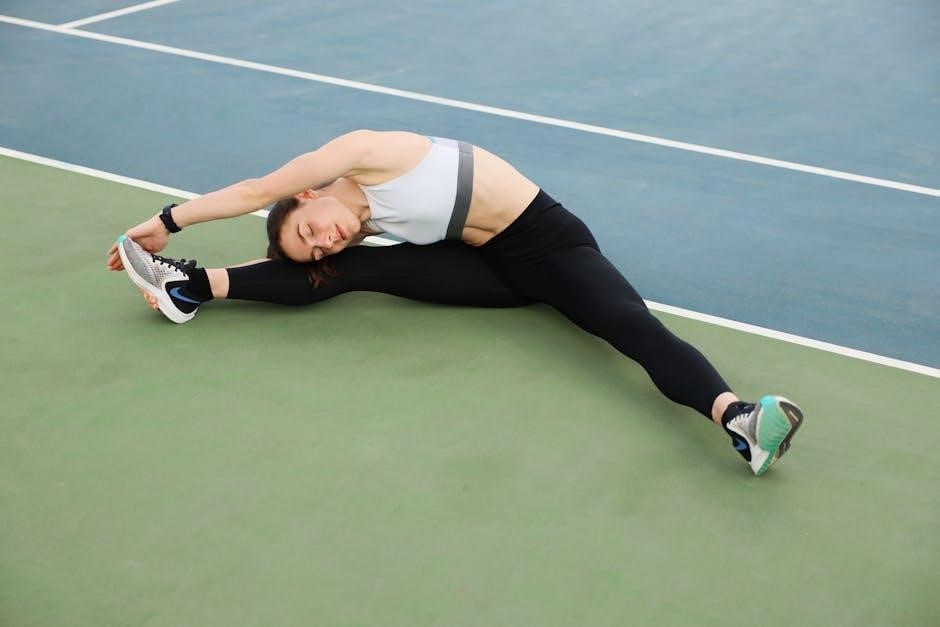
Benefits of Exercise for Greater Trochanteric Bursitis
Exercise is essential for managing greater trochanteric bursitis, offering benefits like reducing pain, improving mobility, and preventing recurrence. It strengthens the hip and glutes, enhancing overall joint function and stability.
3.1 Reducing Pain and Inflammation
Targeted exercises for greater trochanteric bursitis can significantly reduce pain and inflammation by strengthening the surrounding muscles and improving joint stability. Gentle stretching and strengthening movements help alleviate pressure on the bursae, minimizing discomfort. Low-impact activities, such as swimming or cycling, promote blood flow without aggravating the condition. Consistent exercise routines can also reduce swelling and restore normal hip function, providing long-term pain relief and improving overall quality of life.
3.2 Improving Hip Mobility and Strength
Exercises designed to enhance hip mobility and strength are essential for managing greater trochanteric bursitis. Strengthening the glutes, hip abductors, and core muscles helps stabilize the hip joint, reducing strain on the bursae. Gentle stretches improve range of motion, while controlled movements rebuild muscle balance. Stronger hips reduce inflammation and pain, enabling better functional movement and reducing the risk of flare-ups. Regular practice fosters long-term joint health and overall physical function.
3.3 Preventing Recurrence
Regular exercise helps prevent recurrence by maintaining hip strength and mobility. Consistent strengthening of the glutes and hip stabilizers reduces strain on the bursae. Proper form during activities and avoiding repetitive motions minimize irritation. Incorporating low-impact exercises into daily routines supports long-term joint health. Addressing posture and biomechanics further reduces the risk of flare-ups. A balanced approach ensures sustained relief and prevents future episodes of greater trochanteric bursitis.
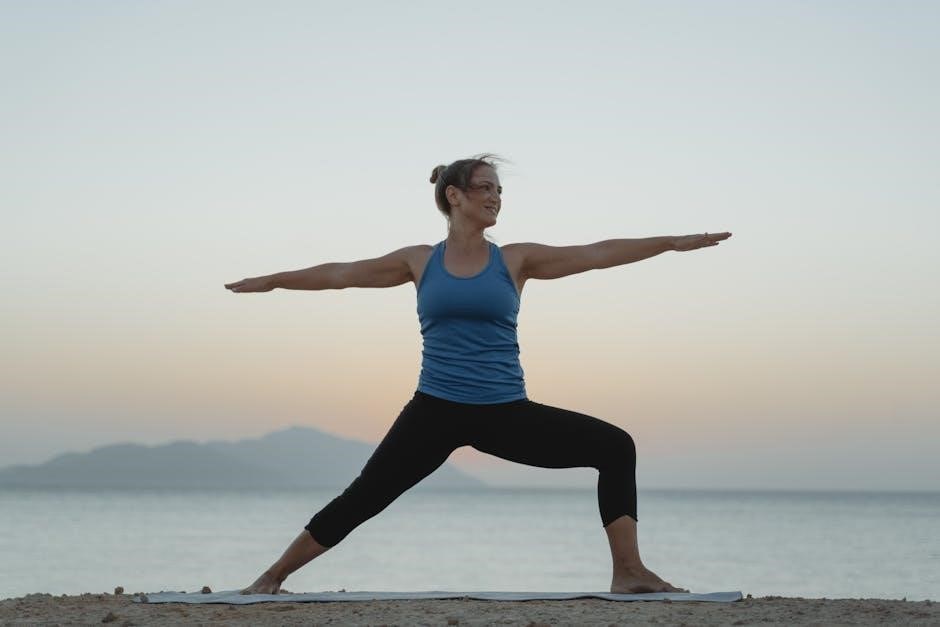
Stretching Exercises for Greater Trochanteric Bursitis
Stretching exercises improve hip flexibility and reduce muscle tightness, alleviating discomfort. Targeting the hip flexors, piriformis, and IT band helps prevent flare-ups and supports recovery. Consistency is key.
4.1 Hip Flexor Stretch
The hip flexor stretch targets tight hip flexor muscles, which often contribute to Greater Trochanteric Bursitis. Kneel on one knee with the other foot forward, keeping your back straight. Gently lean forward, stretching the front of your hip. Hold for 20-30 seconds and repeat on the other side. This stretch improves hip flexibility, reduces muscle tightness, and alleviates pressure on the bursa. Perform it 2-3 times daily for optimal results. Proper form is essential to avoid strain.
4.2 Piriformis Stretch
The Piriformis Stretch is effective for relieving tension in the Piriformis muscle, which can irritate the greater trochanteric bursa. Lie on your back, cross the affected leg over the other thigh, and gently pull the unaffected leg toward your chest. You should feel a stretch in the buttock area. Hold for 20-30 seconds and repeat 2-3 times. This stretch helps reduce muscle tightness and improves hip joint mobility, aiding in pain relief and preventing bursitis flare-ups. Consistency is key for lasting benefits.
4.3 Iliotibial Band (IT Band) Stretch
The IT Band Stretch targets the iliotibial band, a ligament running down the outer thigh, often tight in cases of Greater Trochanteric Bursitis. Stand near a wall for balance, cross the affected leg behind the other, and lean toward the unaffected side until a stretch is felt. Hold for 20-30 seconds and repeat 2-3 times. This stretch reduces outer thigh tightness, eases hip pressure, and improves overall mobility. Regular practice helps alleviate bursitis symptoms and prevents further irritation.
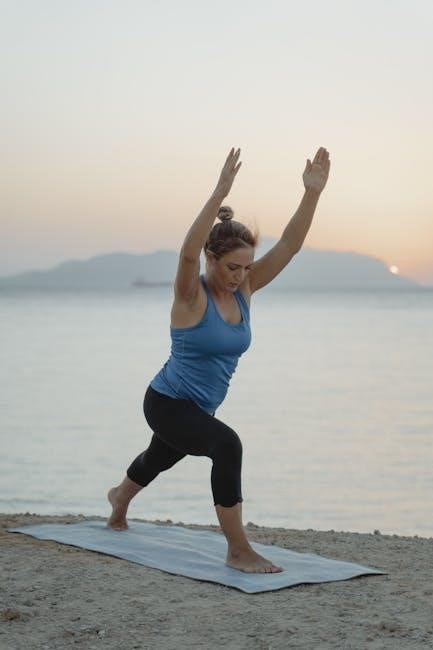
Strengthening Exercises for the Hip and Glutes
Strengthening the hip and glute muscles is essential for stabilizing the hip joint and reducing pressure on the greater trochanter. These exercises improve muscle balance, enhance functional movement, and support long-term recovery from bursitis. By targeting key muscle groups, individuals can restore strength, alleviate pain, and maintain proper hip mechanics for daily activities.
5.1 Glute Bridges
Glute bridges are an excellent exercise for strengthening the gluteus maximus and nearby muscles. Lie on your back with knees bent, feet flat, and arms at your sides. Slowly lift your hips toward the ceiling, squeezing your glutes at the top, then lower back down. This movement improves hip stability and reduces strain on the greater trochanter. Perform 2-3 sets of 12-15 repetitions. Focus on controlled movements to avoid strain and maximize benefits for hip health.
5.2 Side-Lying Leg Lifts
Side-lying leg lifts target the hip abductors, which are essential for hip stability. Lie on one side with legs straight, feet touching. Slowly lift the top leg 12-18 inches, keeping it straight, then lower it back down. Perform 2-3 sets of 12-15 repetitions on each side. Maintain proper form and avoid arching your back. This exercise strengthens the gluteus medius, reducing strain on the greater trochanter and improving overall hip function. Breathing naturally and focusing on controlled movements is key for effectiveness.
5.3 Clamshell Exercise
The clamshell exercise strengthens the gluteus medius, improving hip stability and reducing bursitis symptoms. Lie on your side with knees bent and feet touching. Slowly lift the top knee while keeping feet together, squeezing the glutes. Lower gradually and repeat for 12-15 repetitions. Perform 2-3 sets on each side. Maintain controlled movements and avoid arching your back. This exercise enhances hip stability, reduces pain, and prevents recurrence. Proper form and steady breathing are essential for effectiveness.
Low-Impact Cardiovascular Exercises
Low-impact cardiovascular exercises are essential for managing greater trochanteric bursitis. Activities like swimming, cycling, and using an elliptical improve circulation, strengthen muscles, and support weight management without stressing the hips.
6.1 Swimming and Water-Based Exercises
Swimming and water-based exercises are ideal for greater trochanteric bursitis as they provide a low-impact, weight-bearing environment. The buoyancy of water reduces joint stress while improving circulation and strengthening muscles. Activities like freestyle swimming, backstroke, or water aerobics are excellent choices, as they avoid hip flexion and high-impact movements. Water-based exercises also enhance flexibility and cardiovascular health without aggravating the condition, making them a staple in rehabilitation programs.
6.2 Cycling
Cycling is a low-impact exercise that strengthens hip and leg muscles without putting excessive strain on the hips. Stationary bikes or gentle outdoor rides are ideal, as they allow controlled movement. Cycling improves cardiovascular health and maintains hip mobility. It’s essential to avoid high resistance or intense sprints, which could aggravate the condition. Proper seat height and posture are crucial to minimize strain. Regular cycling can help alleviate symptoms and support overall recovery when done correctly and consistently.
6.3 Elliptical Trainer
An elliptical trainer offers a low-impact, full-body workout that minimizes stress on the hips while improving cardiovascular health. The smooth, circular motion mimics running without the high-impact strain, making it ideal for individuals with Greater Trochanteric Bursitis. To use it effectively, start with short sessions and gradually increase duration and resistance. Proper posture and avoiding overextension are key to preventing discomfort. The elliptical is a versatile option for maintaining fitness and promoting recovery when used consistently and with moderation.
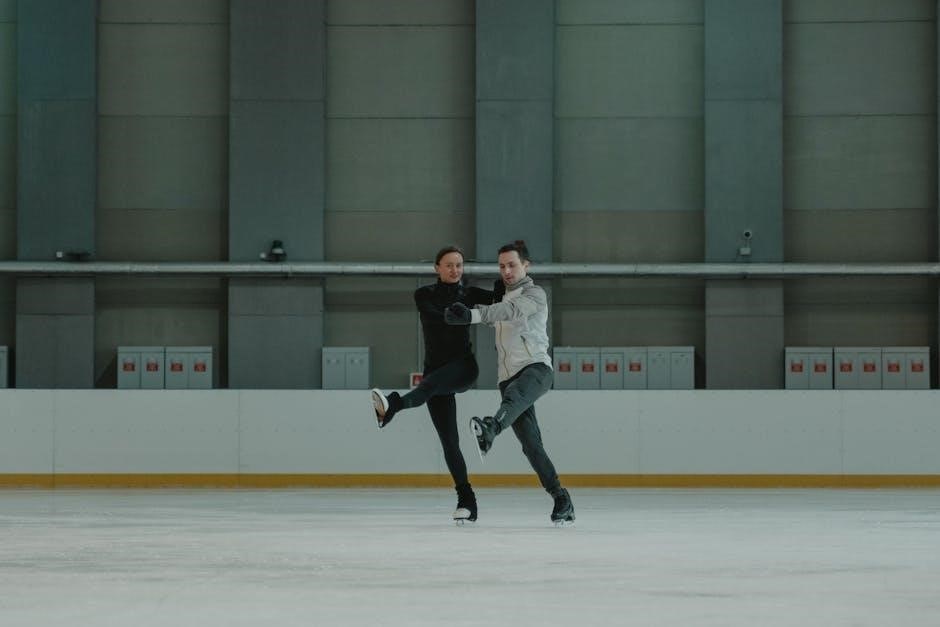
Core Strengthening Exercises
Core strengthening exercises are essential for improving pelvic and hip stability, reducing strain on the trochanteric bursae, and alleviating symptoms of Greater Trochanteric Bursitis.
7.1 Plank
The plank is an effective core-strengthening exercise that improves stability and reduces strain on the hips. To perform, start in a forearm plank position with shoulders over elbows and hips aligned with shoulders. Engage the core, keeping the body straight and rigid. Hold for 20-30 seconds, gradually increasing duration as strength improves. Avoid letting the hips sag or rise too high to maintain proper form and prevent injury. This exercise helps stabilize the pelvis, reducing discomfort associated with Greater Trochanteric Bursitis.
7.2 Bird-Dog Exercise
The bird-dog exercise enhances core stability and improves balance, which is essential for managing Greater Trochanteric Bursitis. Start on hands and knees, engage the core, and extend one arm and the opposite leg simultaneously. Hold for 3-5 seconds, then lower slowly. Repeat on the other side; This exercise strengthens the lower back and hips, promoting proper pelvic alignment and reducing strain on the affected bursae. Perform 8-10 repetitions per side, gradually increasing as strength and control improve.
7.3 Pelvic Tilts
Pelvic tilts are a gentle exercise that improves pelvic mobility and reduces stiffness; Lie on your back with knees bent and feet flat on the floor. Engage your core and slowly tilt your pelvis backward, pressing your lower back into the ground. Hold for 5 seconds, then release. Repeat for 10-12 repetitions. This exercise helps strengthen the pelvic muscles, improve posture, and reduce strain on the hips, making it an excellent addition to your Greater Trochanteric Bursitis management routine. Perform 2-3 sets daily for optimal benefits.
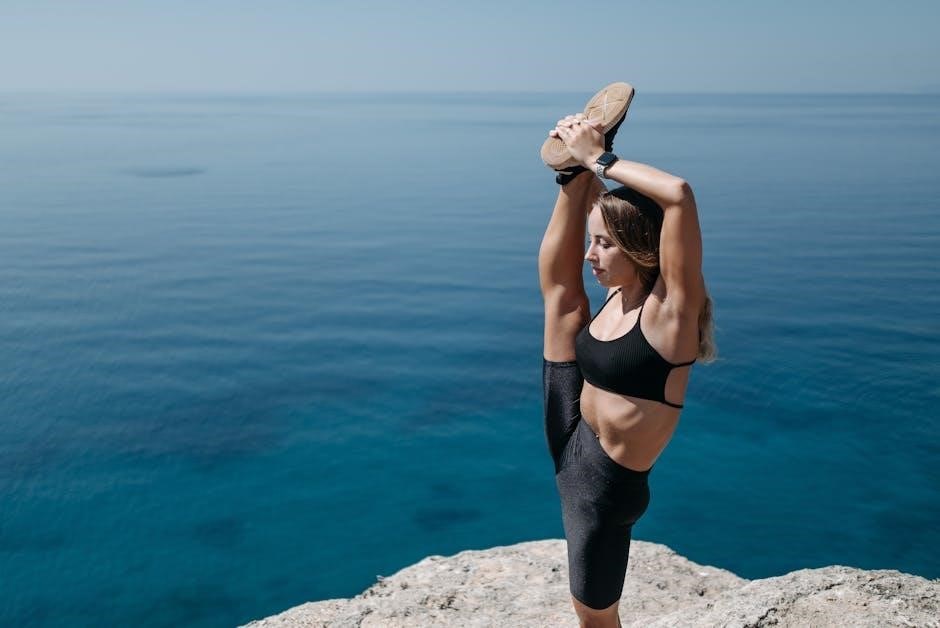
Advanced exercises for Greater Trochanteric Bursitis
Advanced exercises help improve strength, balance, and functionality once initial pain subsides. They are tailored to promote long-term recovery and prevent recurrence, enhancing overall hip stability.
8.1 Step-Ups
Step-Ups are an excellent advanced exercise for strengthening the hip and gluteal muscles. Stand in front of a sturdy step or platform, step up with one leg, and bring the other to meet it. Ensure proper form by keeping the knee in line with the toes and avoiding leaning. This exercise improves hip mobility, strength, and balance. Progress by increasing step height or adding resistance with bands; Start with slow, controlled movements to build confidence and stability.
8.2 Balance Exercises
Balance exercises are essential for improving stability and preventing recurrence of greater trochanteric bursitis. Start with single-leg stands, holding for 30 seconds. Progress to more challenging activities like wobble board or BOSU ball training. Ensure proper form by keeping the knee aligned and core engaged. These exercises enhance proprioception, reduce hip instability, and strengthen surrounding muscles. Gradually increase difficulty by closing your eyes or using unstable surfaces. Always practice near a wall for safety and consider supervision, especially for beginners.
8.3 Resistance Band Workouts
Resistance band workouts are effective for strengthening the hip and gluteal muscles, which helps stabilize the hip joint and reduce bursitis symptoms. Use a light to moderate resistance band for exercises like banded side steps, banded hip abductions, and banded clamshells. These movements target the gluteus medius and minimus muscles, improving hip stability and strength. Perform 2-3 sets of 12-15 repetitions. Focus on slow, controlled movements to avoid aggravating the bursa. Gradually increase resistance as strength improves, ensuring proper form to maximize benefits and prevent further inflammation.
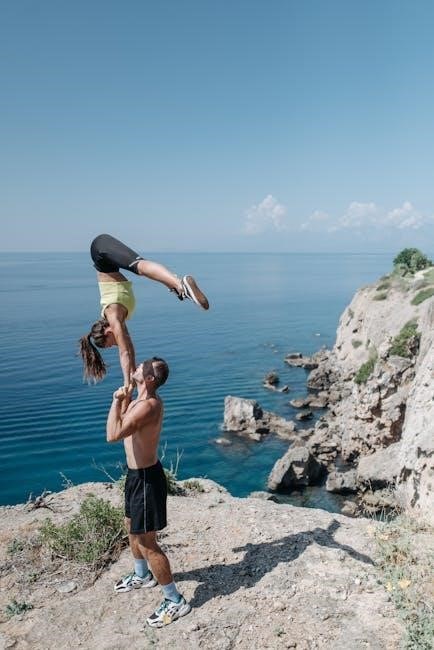
Exercises to Avoid
Certain exercises can worsen greater trochanteric bursitis, such as high-impact activities, deep hip flexion, and prolonged sitting or standing. Avoid movements that strain the hip joint, as they may aggravate symptoms and delay recovery.
9.1 High-Impact Activities
High-impact activities, such as running, jumping, or repetitive pounding, can exacerbate greater trochanteric bursitis by placing excessive strain on the hip joint and surrounding bursae. These movements increase inflammation and pain, hindering recovery. It is essential to avoid such activities and opt for low-impact alternatives, such as swimming or cycling, which promote healing without aggravating the condition. Consulting a healthcare provider or physical therapist can help identify suitable replacements for high-impact exercises in your routine.
9.2 Deep Hip Flexion Movements
Deep hip flexion movements, such as deep squats or lunges, can worsen greater trochanteric bursitis by compressing the bursae and irritating the surrounding soft tissues. These movements increase friction and inflammation, leading to heightened pain and discomfort. Avoiding such exercises is crucial to prevent further irritation and promote healing. Instead, focus on gentle stretches and strengthening exercises that target the hip and glutes without placing excessive stress on the affected area. Always consult a physical therapist to modify exercises safely.
9.3 Prolonged Sitting or Standing
Prolonged sitting or standing can exacerbate greater trochanteric bursitis by placing constant pressure on the hip joint and surrounding tissues. This prolonged pressure can lead to increased inflammation and discomfort. It is important to take regular breaks to move and stretch, especially if your job or lifestyle requires extended periods of sitting or standing. Consider using ergonomic furniture and incorporating gentle movements to reduce strain on the hips. Avoiding prolonged static positions can help alleviate symptoms and support recovery.
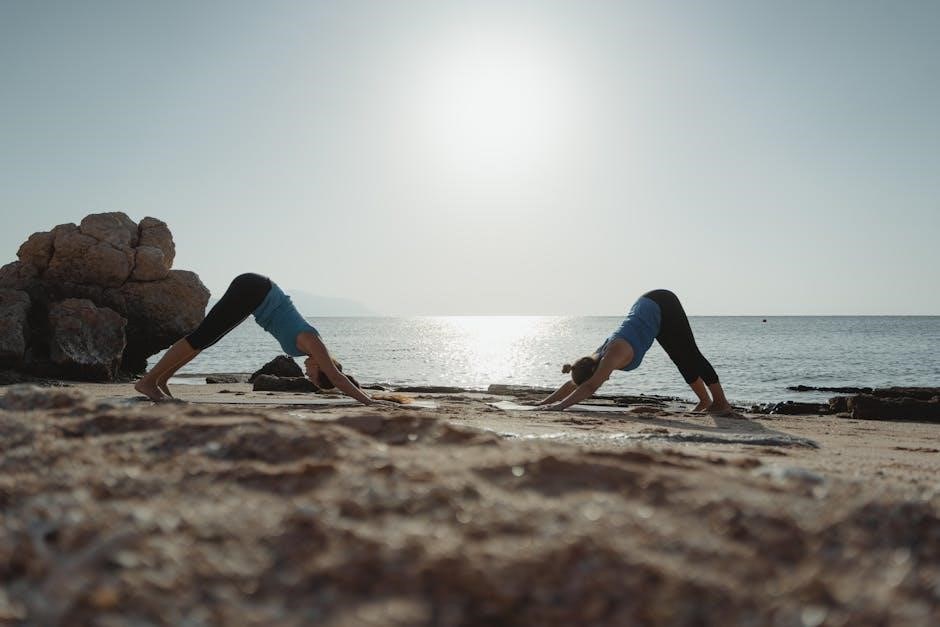
Creating a Personalized Exercise Plan
A personalized exercise plan tailors activities to individual needs, ensuring safety and effectiveness. Consulting a physical therapist, setting realistic goals, and tracking progress are essential steps for success.
10.1 Consulting a Physical Therapist
Consulting a physical therapist is a vital step in creating an effective exercise plan. They assess the severity of bursitis, identify specific needs, and design a program tailored to improve mobility and strength while minimizing pain. A therapist ensures exercises are performed safely and correctly, reducing the risk of further injury. Their expertise also helps address underlying issues, such as muscle imbalances, to promote long-term recovery and prevent recurrence. Professional guidance is essential for achieving optimal results and maintaining progress.
10.2 Setting Realistic Goals
Setting realistic goals is essential for effectively managing greater trochanteric bursitis. Goals should be specific, achievable, and aligned with your current fitness level and recovery progress. Start with short-term objectives, such as performing a set of exercises daily or improving hip mobility. Celebrate small achievements to stay motivated. Long-term goals might include returning to favorite activities or maintaining pain-free movement. Realistic goals help prevent frustration and ensure consistent progress toward overall recovery and well-being.
10.3 Tracking Progress
Tracking progress is vital to ensure the effectiveness of your exercise plan for greater trochanteric bursitis. Monitor improvements in pain levels, mobility, and strength. Keep a journal to log workouts, noting any changes or challenges. Celebrate small milestones, like increased range of motion or reduced discomfort. Regularly assess your goals and adjust them as needed. Consistent tracking helps identify what works best for your condition and keeps you motivated to continue your recovery journey.
Common Mistakes to Avoid
Avoiding overexertion, ignoring proper form, and skipping warm-ups/cooldowns are common mistakes that can worsen symptoms. Consistency and patience are key to effective and safe recovery from greater trochanteric bursitis.
11.1 Overexertion
Overexertion is a common mistake that can exacerbate symptoms of greater trochanteric bursitis. Pushing through pain or performing too many repetitions can lead to increased inflammation and prolonged recovery. It is essential to start slowly, listen to your body, and gradually increase exercise intensity. Ignoring pain signals can result in further damage to the bursae and surrounding tissues. Always prioritize gentle, controlled movements and consult a physical therapist to ensure exercises are performed safely and effectively, avoiding overexertion altogether.
11.2 Ignoring Proper Form
Ignoring proper form during exercises can lead to ineffective results and even worsen symptoms of greater trochanteric bursitis. Poor form places unnecessary strain on the hip joint and surrounding tissues, potentially causing further inflammation or injury. To maximize the benefits of exercises and avoid setbacks, it is crucial to maintain correct posture, alignment, and movement patterns. Working with a physical therapist can help ensure proper technique, while mirrors or video recordings can provide visual feedback to correct any deviations. Consistency and attention to detail are key to achieving long-term improvement and preventing recurrence of the condition.
11.4 Not Warming Up or Cooling Down
Skipping warm-up and cool-down routines can hinder recovery and exacerbate symptoms of greater trochanteric bursitis. Warming up increases blood flow, reduces muscle stiffness, and prepares the hip joint for exercise, lowering the risk of strain or injury. Cooling down helps reduce muscle tension, promote relaxation, and improve recovery. Neglecting these steps can lead to prolonged discomfort and delayed healing; Incorporating gentle stretches and deep breathing exercises into warm-up and cool-down routines ensures a safer and more effective workout experience for individuals managing this condition.
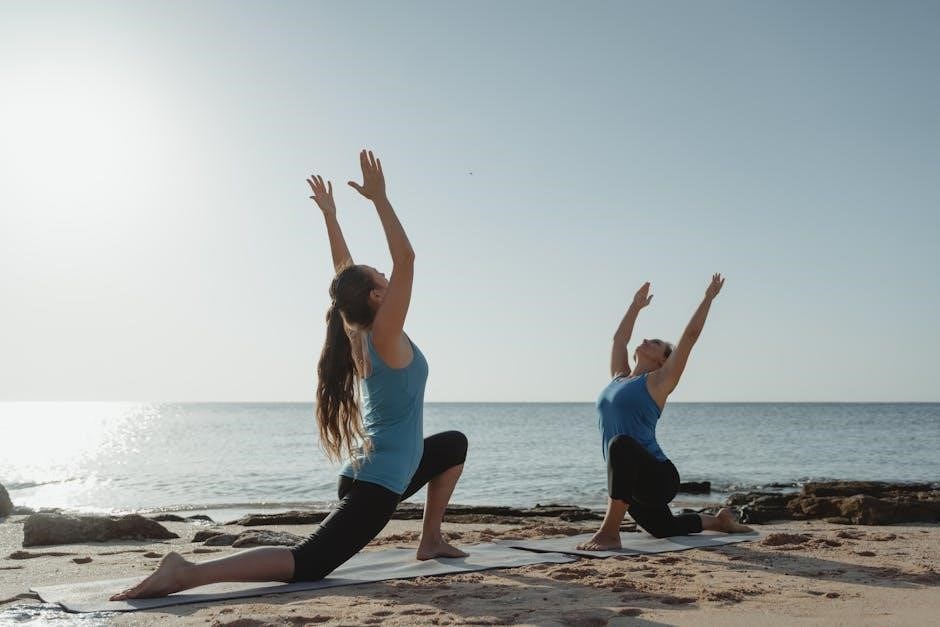
When to Seek Medical Attention
If experiencing severe hip pain, significant mobility loss, or no improvement with exercise, consult a healthcare professional to rule out complications or need further treatment options.
12.1 Severe Pain
Severe pain that disrupts daily activities or worsens over time warrants immediate medical attention. If pain persists despite rest and exercises, or if it becomes unbearable during simple movements like walking or sitting, consult a healthcare provider. Severe pain may indicate underlying issues like tendon tears or infections. Ignoring it could lead to further complications. A doctor may recommend imaging, injections, or other treatments to address the root cause and alleviate symptoms effectively.
12.2 Limited Mobility
Limited mobility, such as difficulty moving the hip or leg, can significantly impact daily activities and quality of life. If mobility becomes severely restricted and does not improve with rest or exercises, seek medical advice. A healthcare provider can assess for potential structural issues, such as tendon tears or nerve compression, and recommend appropriate interventions. Persistent or worsening mobility issues may require physical therapy, bracing, or other treatments to restore function and prevent further complications.
12.3 No Improvement with Exercise
If symptoms of greater trochanteric bursitis persist despite consistent exercise and rest, it is essential to seek medical attention. Persistent pain or lack of improvement may indicate underlying issues requiring further evaluation, such as imaging or injections. A healthcare provider can assess whether additional treatments, like corticosteroid injections or physical therapy, are necessary. Continuing without improvement can lead to chronic pain or further tissue damage, emphasizing the importance of timely medical intervention to ensure proper healing and functional recovery.
Exercise is vital for managing Greater Trochanteric Bursitis, reducing pain, and restoring mobility. Consistency, proper form, and a personalized approach are key to long-term recovery and prevention.
13.1 Summary of Key Points
Greater trochanteric bursitis can be effectively managed through targeted exercises, including stretching, strengthening, and low-impact cardio. These exercises help reduce pain, improve mobility, and prevent recurrence. A personalized approach, guided by a healthcare professional, ensures safety and effectiveness. Avoiding high-impact activities and maintaining proper form are crucial. Consistency and patience are key to achieving long-term relief and restoring hip function. This guide provides a comprehensive roadmap for managing the condition and promoting overall hip health.
13.2 Encouragement for Long-Term Management
Managing greater trochanteric bursitis requires consistency and patience. While progress may seem slow, committing to a tailored exercise routine can lead to significant long-term improvements. Embrace the journey, celebrating small victories along the way. Remember, every effort contributes to reduced pain, improved mobility, and a stronger foundation for daily activities. Stay motivated, seek support when needed, and trust the process. With dedication, you can achieve lasting relief and regain control over your hip health for years to come.